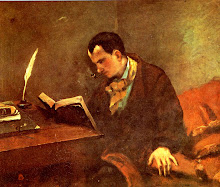Monday, October 26, 2009
Read This, See This
So instead of providing something for a viewer to consider, as the title of a painting would, captions tell the viewer what to see. There is no room for initial interpretation when a caption accompanies a picture. It's just another form of reproduction, but in this case it's the reproduction of thoughts. Someone writes a caption of what they see in a picture and then passes this same thought to the masses. Reproduced thought on reproduced art.
Monday, October 19, 2009
Praise Bell Hooks
I was really intrigued by the information about women keeping women down that Hooks brought up throughout the book. I think it important to blame sexism and not just men for the problems that many women experience. The fact the rich with women often times held other women down solely to get ahead in a patriarchal industry is an important issue to be aware of in concerns with feminism. I also like the points Hooks made about mass media skewing feminism. It's apparent that the media has their own agenda based on profit. This also comes out in Hooks' chapter on beauty, and the commodification of a women. Feminism also deals with action against capitalism and I thought Hooks made great points about comfortable clothes and the fashion industry.
Sunday, October 11, 2009
TMI
Jameson quotes in his essay in relation to “interpretation proper” that:
“This is the place to answer the objection of the ordinary reader, when confronted with elaborate and ingenious interpretations, that the text means just what it says. Unfortunately, no society has ever been quite so mystified in quite so many ways as our own, saturated as it is with message and information, the very vehicles of mystification (language, as Talleyrand put it, having been given us in order to conceal our thoughts)” (184).
I believe that the point he is making here is one of awareness. Not having knowledge about mystification is a great hindrance to the “ordinary reader.” It seems to me naive to think that someone might think that a text meant exactly what it says. In the sentences before the quote, Jameson talks about “interpretation proper” and “strong rewriting,” so is it that the critic must determine what the text is really saying to present to the reader, or should the reader already be doing this? Also, does the reader believe what the critic is saying or should the reader look even deeper into the text interpreting another text?
I will agree that our current age is complex in terms of information and one can be easily tricked into only seeing surface information or don’t care enough to interpret due to the constant stream of information. Jameson's essay brings to mind memes, as they are propagated by information that is recurrent.
Tuesday, October 6, 2009
Art Commodified
I take this quote to mean that in general, people are being creative solely due to the prospect of getting paid for it, and that our system demands that they operate this way. I can see how this plays out in most cases, though some modes of creative expression yileds less payoff. We have put value on creativity and instead of representing feelings or ideas, it is assigned a monetary worth. Art is often times judged on how much it costs. The higher the price, the better the art is supposed to be. Also with odder aesthetic design comes a high price tag and people strive to develop oddball art, design, clothes, etc. to catch that golden dollar sign. I think that one of Jameson's points is that the way we think about creativity, the way we produce a piece, and the way it is seen in society has changed: everything now revolves around money.
